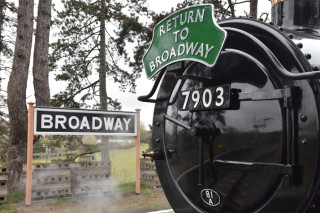Few commercial rail operators seem able to run profitably, as the Virgin East Coast debacle recently demonstrated; but when your railway is run by enthusiastic volunteers, it’s amazing what can be achieved.
The Gloucestershire Warwickshire Steam Railway (GWSR), a heritage line between Cheltenham Racecourse and the Cotswold village of Broadway, has funded its expansion programme without resorting to loans and has seen passenger numbers rise by 62% year-on-year.
The six-year programme to extend the line by two miles from Laverton to the new destination at Broadway was completed this year at a cost of £3m – on time and within budget. This achievement is largely thanks to the 900-plus rail enthusiasts who volunteer their time to operate, maintain and construct the line, thus removing much of the cost.
But managing volunteers requires just as much professionalism as operating any other large labour force – and the GWSR prides itself upon its rigorous professionalism in every aspect, whether it is finance, construction or health and safety.
“Any suggestion that we’re just enthusiasts is both patronising and harking back to a stereotype long gone from this industry,” says the line’s recently-retired finance director, Chris Bristow. Bristow is understandably conscious of the public’s likely perception of an enterprise run by volunteers and with a pop impresario (Kylie Minogue’s producer Pete Waterman of Stock Aitken Waterman fame) as president.
“The GWSR, like other major heritage railways, is first and foremost a business enterprise as well as a major tourist attraction. Our railway is managed by experienced professionals,” says Bristow.
The point is reinforced by Chris Webb, director for health & safety and a Chartered Fellow of the Institution of Safety & Health. “Running a heritage railway isn’t just a hobby, it’s a serious business enterprise that runs to the same rulebook as Network Rail: it’s inspected by the ORR [the Office of Rail and Road] and conforms to ROGS [Railways and Other Guided Transport Systems (Safety) Regulations].”
So even though the GWSR provides the settings for period dramas and runs historic rolling stock for the entertainment of some 100,000-plus visitors a year, this is a modern business. And that’s not always appreciated – even by some volunteers – observes Webb: “Some of our volunteers arrive thinking they can come here and just do what they want. So we have to manage that so they conform to the laws and regulations and do not endanger themselves, their colleagues or the public.”
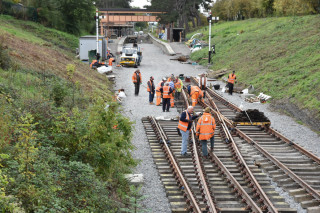
Laying and maintaining the track is carried out by the permanent way team, which now numbers up to 60 members, many of whom have worked in the rail industry with Network Rail, the Ministry of Defence, industrial rail sites and other heritage railways.
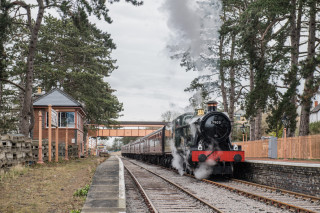
For the Broadway extension, the design team chose to lay continuously welded rail on concrete sleepers from Toddington station approaches to Broadway station approaches – approximately four miles. This eliminated the need for fishplated joints, the bolted plates that join 18m rail lengths on traditional railway track. The advantage of this is that it cuts down on maintenance because while fishplated joints have to be inspected, tightened and greased regularly, a continuously welded track is effectively future-proofed. The downside is that the distinctive ‘clickety-clack’ as the train goes over the joints disappears, so it is not quite authentic.
The permanent way team, led by Lee Alibone, invited Network Rail contractors to bid for the contract to weld the 18m rail lengths supplied by British Steel. The contract was awarded to Chorley-based Haigh Rail. “The contractor carried out the work to the same standard as required by NR, and we received the same sign off paperwork as issued to NR,” he points out.
“Once we had welded 1,000 -1,200 yard (900 – 1,100m) sections the same company carried out the stressing of the CWR sections. The volunteer permanent way team prepared the track, lifted the rails onto rollers, and then re-clipped the rail after the stressing exercise was completed.”
All the construction and restoration work had to be coordinated with the financial resources available, which was organised by Bristow. “The GWSR, due to the covenants entered into at its incorporation in 1981, can’t borrow funds from financial institutions and is an entirely debt-free company,” he explains. “All funding for the railway must come from three sources; operating profits, sale of shares and grants from the Gloucestershire Warwickshire Railway Trust.”
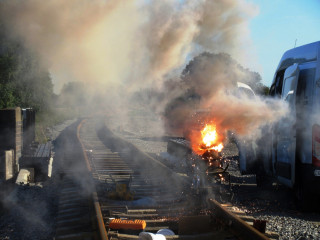
Although the GWSR makes a cash profit every year of at least £200,000, this was not enough to support a £3m capital expenditure program over five years whilst maintaining a viable operating railway, says Bristow. The shortfall was made up from two shares issues: ‘Bridges to Broadway’ in 2014 and ‘Broadway: the last mile’ in 2016/17. The first raised £650,000 to repair the five bridges and the second share issue raised £1.33m. Funding from the Gloucestershire Warwickshire Railway Trust amounted to about £600,000, so these three sources raised enough cash over the five years.
“Good financial and project planning ensured that at no time was work held up through a shortage of funds,” Bristow concludes.
The civil engineering side was most likely to cause cost over-runs because it involved bringing back into service formations and structures that were more than 100 years old and has been disused for the past 50 years. Here the railway could draw on the expertise of the chartered civil engineers amongst its volunteers to minimise the risks.
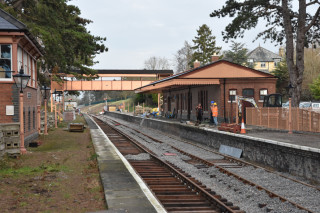

For example, the large embankment at Broadway was one of the most complex structures and the civil engineering team, working with railway consultants, developed a programme of structural analysis and boreholes to determine the composition of the embankment, whether land slips had occurred, and whether drainage mechanisms were working and so on.
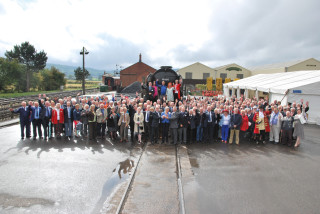
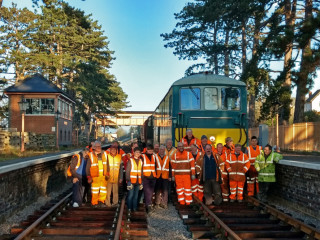
The team and the consultants then defined and agreed a solution, issued a ‘request for quotation’ (RfQ) to competent contractors and then commissioned the work at a time to suit the rest of the railway restoration programme – station development, lineside clearance, boundary fencing, permanent way and signalling work.
“While £3m was being spent on the Broadway extension the existing running line was most definitely not starved of capital, with at least £1m spent on maintaining the infrastructure,” says Bristow.
This ongoing maintenance of the running line falls into two categories: planned upgrades and remedial work. The planned upgrades are carried out during January and February, while the line is closed, and involve replacing sleepers, rails and ballast on sections of track and, this year, refurbishing a steel bridge.
Routine remedial work is carried out as necessary; trained track walkers regularly review the track condition, with each one examining their three-mile section every three weeks. They produce reports identifying any defects so that issues such as cracked fishplates are remedied immediately, while minor issues – such as loose rail clips – are picked up on regular work days. Other ‘eyes’ on the track, such as loco drivers, guards, and drainage/lineside clearance teams will also report back if they see a fault.
The permanent way team has two regular work days each week, on Saturdays and Wednesdays, and an average of 15 volunteers turn up to form the team. This team is led by a nominated experienced member of the department who will define the tasks for the day, allocate tasks to individuals and then supervise the work to ensure that this is completed to standard, and in a safe manner. The team leader then writes a report to document the completed work.
The GWSR has developed its own internal training programmes for volunteers to establish the level of technical knowledge required and learn how to use small equipment. Webb and Alibone commission training providers to deliver more specialised instruction, such as teaching nominated volunteers how to operate larger machines such as telehandlers.
So, for all the nostalgia, the heritage railway must be run at least as professionally as its commuter-carrying equivalent.
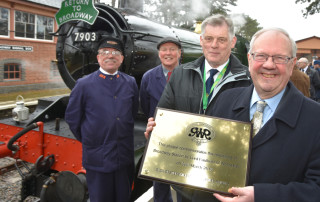
GWSR history in brief
The line on which the GWSR now operates dates back to 1899, when the Great Western Railway obtained an Act of Parliament permitting construction of a double-track railway between Cheltenham and the Worcestershire village of Honeybourne, and the doubling of the single-track route from Stratford-upon-Avon to Honeybourne. This created a through route from the Midlands to the South West to compete with the Midland route that survives today. It opened in 1906, after major civil engineering works including construction of a 680m-long tunnel and a 15-arch viaduct.
GWSR emerged in 1979 out of a movement to persuade British Rail to retain the line. The line had closed in 1976, but British Rail removed the track and remaining infrastructure during 1979 so the GWSR acquired 15 miles of abandoned trackbed with no rails or sleepers. In 1981 it moved into the derelict Toddington station yard – the only station building left standing.
The first train ran in 1984 over a very short (about 730m) track. But now, with its extension to Broadway, the railway operates over nearly 15 miles. The extension cost £3m yet the rail company has no debt and has seen its passenger numbers rise 60% in the months since opening to Broadway on Good Friday, 30th March, this year.
The original line was built to main line standards and so has gentle curves and gradients. It carried a considerable amount of freight – as it linked the industrial West Midlands and South Wales – as well as heavy express trains, such as the The Cornishman, whistling down the track at 80mph with holidaymakers bound for Penzance.
Under British Rail it fell into decline, with no stopping trains scheduled, so that it was simply a diversionary line. The end was signalled when a train carrying coal derailed in 1976, wrecking rails and throwing freight wagons all over the track. This occurred at the very point near Winchcombe where, in 2012, a catastrophic embankment collapse nearly put an end to the GWSR as well.
This article was first published in the July/August 2018 issue of The Construction Index magazine, which you can read for free at http://epublishing.theconstructionindex.co.uk/magazine/july2018/
UK readers can have their own copy of the magazine, in real paper, posted through their letterbox each month by taking out an annual subscription for just £50 a year. See www.theconstructionindex.co.uk/magazine for details.
Got a story? Email news@theconstructionindex.co.uk

